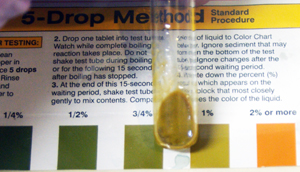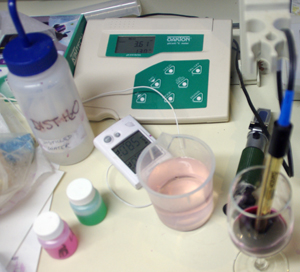 While racking, I ran a sugar test and pH on the wine. Running the sugar test reminded me of high school chemistry class when we used pH paper to match a substance to a color chart with 14 indicators. The sugar test kit that many winemakers use is the Clinitest Reagent Tablets for Urine Sugar Testing. Why reinvent the wheel? If there is already something on the market that does what you want, use it. The process is the same for wine. We were sure that the sugar levels were between zero percent and two percent so we used the five-drop test. Five drops of wine were placed in a test tube followed by ten drops of distilled water. A reagent tablet was added to the test tube. After fizzing you wait for fifteen seconds, then match the color in the test tube with the color on a chart. This gives a reading of the sugar level in the wine. The wines we tested were between zero and two percent risudual sugar. Fermentation will continue to take place while in the barrel.
While racking, I ran a sugar test and pH on the wine. Running the sugar test reminded me of high school chemistry class when we used pH paper to match a substance to a color chart with 14 indicators. The sugar test kit that many winemakers use is the Clinitest Reagent Tablets for Urine Sugar Testing. Why reinvent the wheel? If there is already something on the market that does what you want, use it. The process is the same for wine. We were sure that the sugar levels were between zero percent and two percent so we used the five-drop test. Five drops of wine were placed in a test tube followed by ten drops of distilled water. A reagent tablet was added to the test tube. After fizzing you wait for fifteen seconds, then match the color in the test tube with the color on a chart. This gives a reading of the sugar level in the wine. The wines we tested were between zero and two percent risudual sugar. Fermentation will continue to take place while in the barrel.
 To determine the pH, I placed a probe into the wine. The probe was connected to an Oakton pH meter. It only took about a minute to get a reading.
To determine the pH, I placed a probe into the wine. The probe was connected to an Oakton pH meter. It only took about a minute to get a reading.
Why was this data important? It lets the winemaker know that since there is still sugar in the wine, the wine will continue to ferment. The pH was in the desired range so no additions need to be made at this time. Throughout the aging process, data will be collected and analyzed.



Leave a Reply